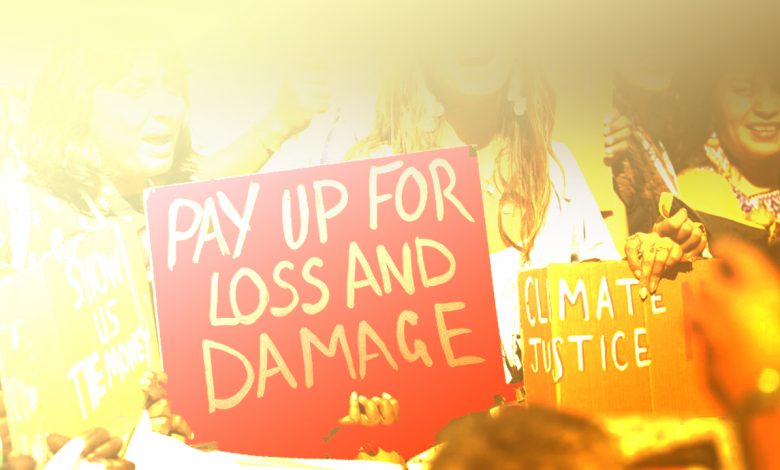Daily Current Affairs for UPSC
Loss and Damage Fund for Climate Damages

Topic- Environment and Ecology [GS Paper-3]
Context- At the recently COP27 summit, delegates from the United Nations agreed to create a ‘Loss and Damages’ fund which will compensate the most vulnerable countries for their losses due to climate-related disasters.
Key Highlights
- Delegates at the U.N.’s climate conference in Sharm el-Sheikh, Egypt thrashed out an agreement to establish a ‘Loss and Damages’ fund to compensate the most vulnerable countries for damages from climate-linked disasters.
- Crucial questions such as who will manage this fund, whether contributions are expected from large developing countries; whereas what the fair share of contributors will be have been left to a “transitional committee” that will make recommendations to enable the actual adoption of the fund at the next Conference of the Parties (COP) of the U.N.’s Framework Convention for Climate Change, to be held in the United Arab Emirates next year.
- It was only appropriate that this COP, the implementation COP in Africa, is where the fund is finally established.
- The agreement and pledges made on loss and damage aim at unlocking greater ambitions for mitigation and adaptation.
- During the COP27 meeting, financial pledges for loss and damage funding came from multiple countries, including Austria, Belgium, Canada, France, Germany, and New Zealand, joining Denmark and Scotland, which had made pledges previously.
- The expected monetary compensation from the L&D fund is estimated to be nearly $500 billion and rising by $200 billion annually.
- Delivering such funding will require a swift and comprehensive transformation of the financial system and its structures and processes, engaging governments, central banks, commercial banks, institutional investors and other financial actors.
- Prior to COP27, India had set out for itself the task of having countries make progress on climate finance. However, this saw limited success.
- Serious concern was expressed that the goal of developed country Parties to mobilize jointly $100 billion per year by 2020 has not yet been met, with developed countries urged to meet the goal, and multilateral development banks and international financial institutions called on to mobilize climate finance.
- COP27 also saw the launch of a “mitigation work programme” which would start this year and continue until 2030, with at least two global dialogues held each year.
- Under this Governments were requested to revisit and strengthen the 2030 targets in their national climate plans by the end of 2023, as well as accelerate efforts to phase down unabated coal power and phase-out inefficient fossil fuel subsidies.
- While a notional funding arrangement for L&D has been agreed upon, its shape and scale are far from clear.
‘Loss and Damage’ Funding
- ‘Loss and Damage’ means the impacts of climate change that cannot be avoided either by mitigation i.e. cutting greenhouse gas emissions or adaptation i.e. modifying practices to buffer against climate change impacts.
- They include not only economic damage to property but also loss of livelihoods, and the destruction of biodiversity and sites that have cultural importance.
- This funding broadens the scope for affected nations to claim compensation.
Evolution of the Concept of Loss and Damage
- Since the United Nations Framework Convention on Climate Change was established in the early 1990s, loss and damage due to climate change have been debated.
- The under Developed Countries Group has long aimed to establish accountability and compensation for loss and destruction.
- However, historically blamed for the climate catastrophe, developed countries have overlooked the concerns of vulnerable countries.
- Warsaw International Mechanism on Loss and Damages (WIM) was adopted in 2013 without funding after extensive pressure from developing countries.
- However, during the 2021 COP26 climate summit in Glasgow, a 3-year task force was formed to consider a funding arrangement for loss and damage.
- So far, Canada, Denmark, Germany, New Zealand, Scotland and the Belgian province of Wallonia have all expressed their interest in loss and damage funding.
Concerns regarding the Establishment of the Fund
- As far as future COP negotiations are concerned, it only commits to creating a fund and leaves it up to discussion how it will be set up and who will contribute to it.
- While there have been nominal commitments by certain nations to donate to such a fund, the estimated L&D is already over USD 500 billion.
- During negotiations in COP27, the European Union pressed hard for China, the Arab states and other large, developing countries to contribute on the grounds that they were large emitters.
- There is no agreement yet on what counts as “loss and damage” caused by climate change – which could include infrastructure damage, property damage, and cultural assets whose value is hard to estimate.
- Climate funding till now has focused mostly on cutting carbon dioxide emissions in an effort to curb global warming, while about a third of it has gone toward projects to help communities adapt to future impacts.
India’s Related Initiatives
- National Adaptation Fund for Climate Change (NAFCC) was established in 2015 to meet the cost of adaptation to climate change for the State and Union Territories of India that are particularly vulnerable to the adverse effects of climate change.
- The National Clean Energy Fund was created to promote clean energy, and funded through an initial carbon tax on the use of coal by industries.
- It is governed by an Inter-Ministerial Group with the Finance Secretary as its Chairman.
- Its objective is to fund research and development of innovative clean energy technology in the fossil and non-fossil fuel-based sectors.
- National Adaptation Fund was established in 2014 with a corpus of Rs. 100 crores with the aim of bridging the gap between the need and the available funds.
- This fund is operated under the Ministry of Environment, Forests, and Climate Change (MoEF&CC).
Way Ahead
- While the gain is incremental, countries ought not to lose momentum and must work together to ensure that COPs remain credible catalysts and are not mere occasions for some hollow victories.
- Further, there is a need to sustain a political commitment to raising new finance, besides, ensuring that finance is better targeted at reducing emissions and vulnerability related to it, learning and improving from recent experiences, particularly as the Green Climate Fund gets to work.





.png)



